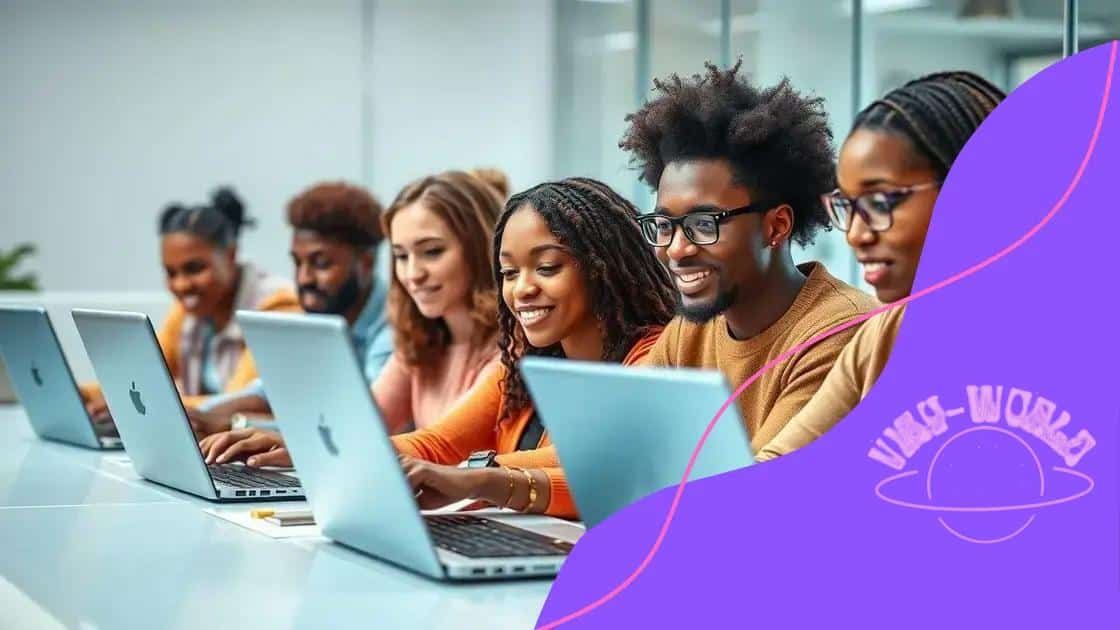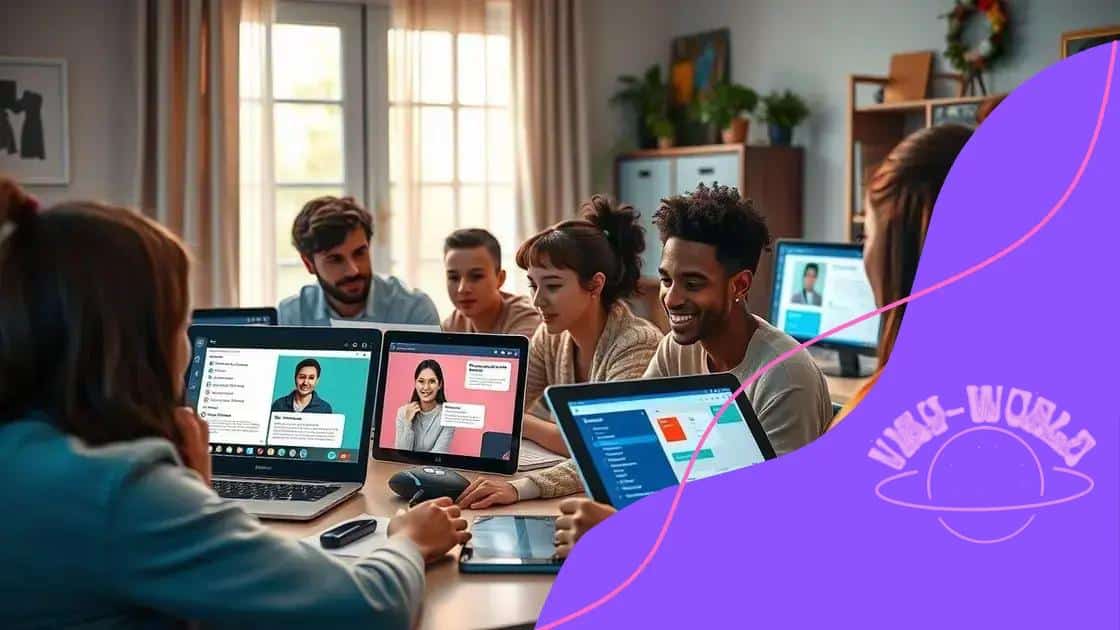The impact of virtual classrooms on student collaboration

The impact of virtual classrooms on student collaboration is significant, utilizing technology to enhance interaction, engagement, and the learning experience while facing challenges such as communication barriers and technical issues.
The impact of virtual classrooms on student collaboration is something many educators are starting to explore. They create unique opportunities for students to connect, share ideas, and work together from different locations. Have you ever wondered how this affects your learning experience?
Understanding virtual classrooms
Understanding virtual classrooms is essential as they become a key part of modern education. These digital learning environments allow students to connect and collaborate from anywhere in the world. By using innovative technology, virtual classrooms offer a unique platform for personalized learning experiences.
Features of Virtual Classrooms
Virtual classrooms are designed to enhance student engagement and collaboration. They incorporate various features that make learning interactive.
- Live video sessions: Students and teachers can communicate in real time.
- Discussion forums: Platforms for students to share ideas and resources.
- Digital whiteboards: Tools for brainstorming and visualizing concepts together.
- Recorded sessions: Allow students to revisit lessons at their convenience.
These elements create a dynamic learning atmosphere. Students feel more involved, as they can participate actively. For instance, during live discussions, students can ask questions immediately. This immediate feedback loop keeps them engaged and clarifies misunderstandings on the spot.
Benefits of Virtual Learning Environments
One significant advantage of virtual classrooms is flexibility. Students can access materials and participate in classes from any location. This is particularly beneficial for those balancing work or family commitments. Additionally, the varied tools and resources available cater to different learning styles, making education more accessible for everyone.
Moreover, virtual classrooms provide students with opportunities to connect with peers across the globe. This exposure helps them gain different perspectives and insights. They can collaborate on projects remotely, share ideas, and create a diverse learning community.
Integrating technology into the learning process prepares students for the future job market. Skills like digital communication and online collaboration are increasingly vital. By engaging in virtual classrooms, students learn to navigate these platforms effectively.
Understanding the potential of virtual classrooms encourages educational institutions to adapt to this evolving landscape. By embracing technology, they can better serve their students and improve learning outcomes overall.
Benefits of collaboration in online learning
Collaboration in online learning brings many benefits that enhance students’ educational experiences. By working together, students can share knowledge and gain new perspectives. This type of engagement fosters a deeper understanding of the material.
Increased Engagement
When students collaborate, they are often more engaged in their learning. They participate actively, which can lead to better retention of information.
- Interactive discussions: Conversations with peers keep students interested.
- Shared resources: Collaborating allows students to exchange useful materials.
- Peer support: Students can help each other with difficult concepts.
This collaborative environment encourages students to ask questions and seek help. When they feel supported by classmates, their confidence grows, encouraging them to participate more.
Development of Critical Skills
Engaging in collaborative projects helps students develop important skills they will use in their future careers. They learn how to communicate effectively and work as part of a team.
These skills include problem-solving, critical thinking, and creativity. In online settings, students often use various tools to collaborate, enhancing their digital literacy as well.
Moreover, such collaborations can also lead to a sense of community among students. They build relationships that might extend beyond the classroom, creating friendships and professional networks.
As students interact with diverse peers, they broaden their cultural awareness. This exposure helps them develop empathy and respect for different viewpoints, essential qualities in today’s globalized world.
Ultimately, the benefits of collaboration in online learning environments are significant. They not only promote academic success but also prepare students for the challenges of a collaborative workplace.
Tools that enhance student interaction

In a virtual classroom, having the right tools can greatly enhance student interaction. These tools foster collaboration and engagement, making learning more effective and enjoyable. Let’s explore some popular tools that support student interaction in online learning environments.
Communication Platforms
Communication tools allow students to connect with each other and their instructors easily. They help foster discussions, share ideas, and ask questions.
- Video conferencing: Tools like Zoom or Microsoft Teams enable real-time interactions, allowing face-to-face communication.
- Chat applications: Platforms such as Slack or Discord support instant messaging for quick questions and discussions.
- Email services: These remain a vital way for students and teachers to communicate outside of class hours.
By using these communication platforms, students can easily collaborate on projects and stay engaged with their coursework. They create a sense of community, even when physically apart.
Collaborative Tools
Another important category of tools is collaborative platforms that allow students to work together on assignments in real time. These tools enhance teamwork and make learning more interactive.
- Document sharing: Google Docs and Microsoft Office 365 enable multiple users to edit and comment on documents simultaneously.
- Presentation software: Tools like Google Slides allow groups to create presentations together, which can enhance their learning experience.
- Project management apps: Platforms such as Trello or Asana help students coordinate tasks and deadlines for group projects.
These tools allow students to contribute their ideas effectively, encouraging a diverse range of thoughts and approaches. By working together, they can solve problems and accomplish tasks more efficiently.
The combination of communication and collaborative tools ensures that students can interact in meaningful ways. This interaction not only helps them learn course material but also equips them with essential skills they will need in their future careers.
Challenges of virtual collaboration
While virtual collaboration offers many benefits, it also comes with its share of challenges. Understanding these obstacles is essential for creating effective online learning environments. Some students may struggle with the technology required for virtual collaboration. If they are not familiar with the tools, they can feel overwhelmed and disengaged.
Technical Issues
Technical difficulties can disrupt the flow of online learning. Connection problems, software glitches, or compatibility issues may occur, hindering collaboration.
- Poor internet connection: Students may experience lag or drop outs during live sessions.
- Device compatibility: Not all devices support the same applications, causing access issues.
- Learning curve: Some students may need more time to understand how to use different tools effectively.
These technical challenges can lead to frustration. When students cannot participate fully, they may miss out on valuable interactions with their peers.
Communication Barriers
Effective communication is crucial for collaborative learning, but virtual settings can make it difficult. Non-verbal cues, which are often lost in online formats, help convey emotions and reactions. Misunderstandings may arise from unclear messages.
Additionally, differences in time zones can impact collaboration. Scheduling meetings that work for everyone can be challenging. Some students might struggle to participate in group discussions due to conflicting schedules or availability.
Another issue is the feeling of isolation. In a physical classroom, students often find support from their peers. However, in a virtual environment, they may feel disconnected. This lack of social interaction can lead to decreased motivation and participation.
Recognizing and addressing these challenges is vital for improving virtual collaboration. By doing so, educators can create a more inclusive and engaging online learning experience.
Future trends in virtual classrooms
As technology continues to evolve, so do virtual classrooms. Understanding the future trends in this area can help educators and students prepare for new learning experiences. One significant trend is the increasing use of artificial intelligence (AI) in education. AI can provide personalized learning experiences, adapting to each student’s needs and progress.
Adaptive Learning Technologies
These technologies analyze student performance and adjust content accordingly. With AI, students can receive tailored resources and activities that suit their specific learning styles.
- Real-time feedback: AI can offer instant feedback on assignments, helping students understand mistakes immediately.
- Customized learning paths: Students can progress through materials at their own pace, ensuring they master a topic before moving on.
- Predictive analytics: AI tools can identify students who may need additional support, allowing educators to intervene early.
Another trend is the integration of virtual and augmented reality (VR and AR) in classroom settings. These immersive technologies create engaging learning environments that make complex topics easier to understand.
Immersive Learning Experiences
With VR and AR, students can explore historical sites, conduct science experiments, or delve into complex theories in a hands-on way. This experiential learning enhances understanding and retention.
Additionally, social learning is gaining momentum. More platforms are focusing on collaboration tools that encourage peer-to-peer interaction. This trend reflects the understanding that students learn effectively from one another.
Online discussion groups, collaborative projects, and peer reviews are becoming common in virtual classrooms. By building connections, students create a supportive learning community that fosters engagement and motivation.
As we look ahead, focusing on inclusivity will also be vital. Developers are working to ensure that virtual classrooms are accessible to all students, including those with disabilities. This means designing platforms that accommodate different learning needs.
Overall, the future of virtual classrooms is bright. Embracing new technologies and trends will lead to more effective and inclusive learning experiences for students.
FAQ – Frequently Asked Questions about Virtual Classrooms
What are virtual classrooms?
Virtual classrooms are online learning environments where students and teachers interact using technology, allowing for remote education.
How do virtual classrooms enhance collaboration?
They use various tools that facilitate communication and teamwork, enabling students to work together on projects and share ideas in real time.
What challenges do students face in virtual classrooms?
Students may encounter technical issues, such as poor internet connection, and communication barriers can make collaboration difficult.
What are some future trends in virtual classrooms?
Future trends include the use of artificial intelligence for personalized learning, as well as the integration of virtual and augmented reality for immersive experiences.





